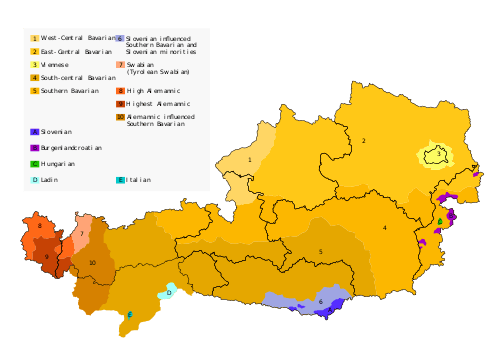Languages of Austria
| Languages of Austria | |
|---|---|
| Official languages | German (Austrian German) |
| Significant unofficial languages |
Alemannic Austro-Bavarian |
| Regional languages | Burgenland Croatian, Slovene, Hungarian, Czech, Slovak, Romani |
| Minority languages | Serbian, Turkish |
| Main foreign languages |
German English (73%) French (11%) Italian (9%) |
| Sign languages | Austrian Sign Language |
| Common keyboard layouts | |
| Source | ebs_386_en.pdf (europa.eu) |

The languages of Austria include German, the official language and lingua franca; Austro-Bavarian, the main dialect outside Vorarlberg; Alemannic, the main dialect in Vorarlberg; and several minority languages.
German
German is the national official language and constitutes a lingua franca and de facto second language: most Austrians other than (mostly rural) seniors are able to speak it. It is the language used in media, in schools, and formal announcements. The variety of German used, Austrian German, is partially influenced by Austro-Bavarian and uses many "Germanized" words.
Alemannic
Alemannic is spoken in Vorarlberg. Vorarlberg uses a High Alemannic, the same dialect group as that spoken in Northern Switzerland (outside Basel) and parts of southern Alsace, France. To most Germans and Austrians outside of Vorarlberg it is very difficult to understand, as it is more similar to Swiss German, with many grammatical and pronunciation differences.
Austro-Bavarian
The main native language of Austria outside Vorarlberg is Austro-Bavarian, whose many regionally different dialects are spoken. The north-eastern parts of Austria (with the capital Vienna) speak Central Austro-Bavarian dialects and the southern parts Southern Austro-Bavarian dialects. Austro-Bavarian differs a lot from Standard German, making it very difficult for German speakers of different regions to understand the native population. Austro-Bavarian has no official orthography, but there are literary efforts (de:Dialektliteratur), especially in poems, to depict the sound of the pronunciation in the spelling. Other words can only be heard while visiting particular regions of Austria and Bavaria that are only rarely used in Standard German, including "Griaß God" (literally: "greet god" = may god greet you), and "Servus/Servas" (at your service) as greeting phrases, or are denoted as strictly dialectal, like "Pfiat di" (literally: "watch over you [god]" = may God watch over you) with the meaning of "goodbye". This particular example also shows that the Austro-Bavarian grammar differs from Standard German.
Minority languages
A number of minority languages are spoken in Austria, some of which have official status.
Turkish
Turkish is the largest minority language, in a situation mirroring that of Germany, spoken by 2.3% of the population.
Serbian
Serbian is the second largest minority language, with usage by 2.2% of the population.[1]
Burgenland Croatian
Burgenland Croatian, an official language in Burgenland, is spoken by 2.5% of Austrians, and Burgenland Croats are recognized as a minority and have enjoyed special rights following the Austrian State Treaty (Staatsvertrag) of 1955.
Hungarian
.png)
While little spoken today, Hungarian has traditionally held an important position in Austria (or, more correctly, Austria-Hungary). Today, Hungarian is spoken by around 1,000 people in Burgenland.
Slovene
Slovene is an official language in Carinthia. As of the census in 2001 Slovene is used by 12,686 Austrians as vernacular, and it is reported that Slovene can be spoken by 0.3% of Austrians. Carinthian Slovenes are recognized as a minority and have enjoyed special rights and affirmative action following the Austrian State Treaty (Staatsvertrag) of 1955.
European Charter for Regional or Minority Languages
Austria ratified the European Charter for Regional or Minority Languages on 28 June 2001 for the following languages in respect of specific Länder:
References
- ↑ "Archived copy". Archived from the original on January 23, 2010. Retrieved January 23, 2010.
![]()
External links
| Wikimedia Commons has media related to Languages of Austria. |
